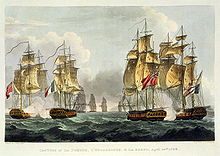| This article includes a list of general references, but it lacks sufficient corresponding inline citations. Please help to improve this article by introducing more precise citations. (February 2014) (Learn how and when to remove this message) |
| Action of 23 April 1794 | |||||||
|---|---|---|---|---|---|---|---|
| Part of the naval operations during the War of the First Coalition | |||||||
 Capture of Pomone, Engageante and Babet by Thomas Whitcombe | |||||||
| |||||||
| Belligerents | |||||||
|
|
| ||||||
| Commanders and leaders | |||||||
|
|
| ||||||
| Strength | |||||||
|
3 frigates 1 corvette | 5 frigates | ||||||
| Casualties and losses | |||||||
|
2 frigates and the corvette captured. Pomone: 80 and 100 killed and wounded Babet: 30 and 40 killed and wounded Engageante: 30 to 40 men killed and wounded |
Flora: 1 killed, 3 wounded Arethusa: 3 killed, 5 wounded Melampus : 5 killed, 5 wounded Concorde: 1 killed, 12 wounded | ||||||
The action of 23 April 1794 took place between a British squadron of five frigates under the command of Sir John Borlase Warren and three frigates and a corvette under the command of Chef d'escadre F. Desgarceaux during the French Revolutionary Wars. Three of the French ships were captured.
The battle
On 21 April the frigate Minerva sighted four distant ships in the English Channel. The next morning Minerva met Warren's squadron, and passed this information on. Warren promptly set off in pursuit, and at dawn the next day, around 4 a.m., sighted three frigates and a corvette about seven or eight leagues (24.5–28 nautical miles) south-west of Guernsey. The French formed a line of battle, and Warren signalled his squadron to engage, with his own flagship Flora in the lead, supported by Arethusa. Taking advantage of the weather gage the British were able to force the French into a close action which lasted for nearly three hours, before the Pomone and Babet surrendered at around 11 a.m.
The Engageante and Résolue attempted to escape, and Warren ordered Concorde, Melampus and Nymphe to pursue, as Flora was in no condition to do so. After an hour Concorde caught up with Engageante and attempted to disable her, intending to then attack the Résolue, leaving Engageante to Melampus and Nymphe, which were following.
However, while Concorde was engaged with Engageante, the Résolue dropped back and laid herself across Concorde's bows, badly damaging her sails and rigging to the point where she was disabled. Having made hasty repairs Concorde came up again to re-engage the Engageante, which eventually surrendered at about 1.45 p.m. Résolue fired a few shots and then made off, pursued by Melampus and Nymphe, who chased her into Morlaix, before returning to assist Concorde which was towing the crippled Engageante to port.
Ships
Britain
- Flora, (36) Sir John Borlase Warren, flagship
- Arethusa, (38) Sir Edward Pellew
- Melampus, (36) Thomas Wells
- Concorde, (32) Sir Richard Strachan
- Nymphe, (36) George Murray
France
- Engageante, (26) F. Desgarceaux, flagship - captured by Concorde
- Pomone, (44) Étienne Pévrieu - captured by Arethusa
- Résolue, (36) Antoine-Marie-François Montalan - escaped
- Babet, (22) Pierre-Joseph-Paul Belhomme - captured by Arethusa
See also
![]() Media related to Action of 23 April 1794 at Wikimedia Commons
Media related to Action of 23 April 1794 at Wikimedia Commons
References
- Rouvier
- ^ "The late Sir Richard Strachan". The Naval and Military Magazine. 3: 256. 1828. Retrieved 22 April 2011.
- ^ Parkinson, C. Northcote (2008). "The Life of Edward Pellew, Viscount Exmouth". pellew.com. Retrieved 22 April 2011.
- ^ "No. 13646". The London Gazette. 28 April 1794. pp. 377–379.
- Rouvier, Charles (1868). Histoire des marins français sous la République, de 1789 à 1803 (in French). Arthus Bertrand.
Categories: